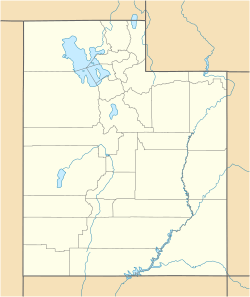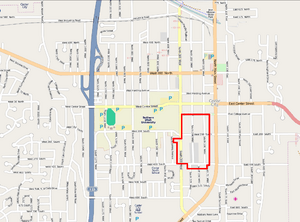Cedar City Historic District facts for kids
Quick facts for kids |
|
|
Cedar City Historic District
|
|
| Location | Roughly bounded by 100 West and 300 West, College Ave., and 400 South Cedar City, Iron County, Utah, U.S. |
|---|---|
| Architectural style | Tudor Revival, Bungalow, American Craftsman, Victorian, Prairie School, Renaissance Revival, Colonial Revival, International Style |
| NRHP reference No. | 04000677 |
| Added to NRHP | July 7, 2004 |
The Cedar City Historic District is a special collection of 172 buildings in Cedar City, Utah. More than 100 of these buildings are important because they show the history of the area.
Cedar City started as a place for making iron. Later, many people left. But the families who stayed found success raising sheep. In the early 1900s, the Union Pacific Railroad came to town. This brought many tourists to Cedar City.
The district includes some of the oldest homes in Cedar City. Many belonged to farmers or ranchers. Newer houses in the district show popular building styles from the early 1900s.
Contents
History of Cedar City
After Brigham Young founded Salt Lake City in northern Utah Territory, he sent groups of Mormon families to settle new areas. Young wanted the Latter-day Saint state to be self-sufficient. Iron was a very important resource they needed.
Founding the Iron Works
In 1851, Young sent 161 people, led by Jens Nielson, to start the city of Parowan. Their goal was to find and use nearby iron deposits. The iron was found in what is now Cedar City. In November 1851, 35 men built an iron works there. Young officially made Cedar City a town a few months later. The iron mined here was the first west of the Mississippi River.
After some problems, Young ordered the iron works to close in 1858. Most people left Cedar City. But 301 people decided to stay.
Growth and New Industries
For the next few decades, Cedar City was a farming town. Raising sheep became a very good business for the settlers. This success allowed many families to build large, two-story brick homes. By 1880, the population grew to 740 people. This meant more public and religious buildings were needed.
Branch Agricultural College was started in 1897. By 1904, the city had electricity and plumbing. In 1899, the town raised $100,000 to buy land for the Union Pacific Railroad.
The Railroad and Tourism Boom
Once the railroad arrived, Cedar City focused on bringing in tourists. The city was close to amazing places like Cedar Breaks National Monument, Zion National Park, Grand Canyon National Park, and Bryce Canyon National Park. The Union Pacific Railroad advertised these parks. Tourists would arrive in Cedar City by train and then take buses to the parks.
Cedar City's population doubled in the 1920s. Most people in the historic district still worked in agriculture. But new residents brought different building styles. These included Colonial, Tudor, and Renaissance Revival buildings. The city faced challenges during The Great Depression. However, new iron mines opened after World War II, which helped the economy grow again.
Historic Buildings Today
About 11% of the important buildings in the district were built before the 1920s. Almost all of the important buildings (98%) are homes. The Cedar City Historic District was added to the National Register of Historic Places on July 7, 2004. This means it is recognized as a special place in American history.
Images for kids
- National Register of Historic Places Registration Form: Cedar City Historic District and accompanying photos





